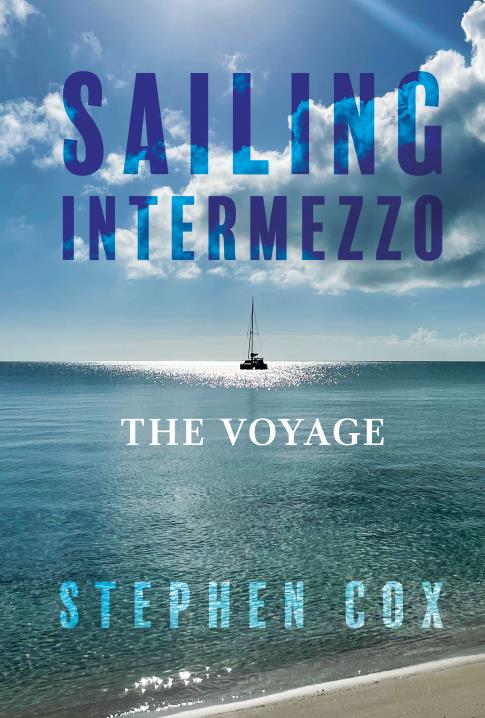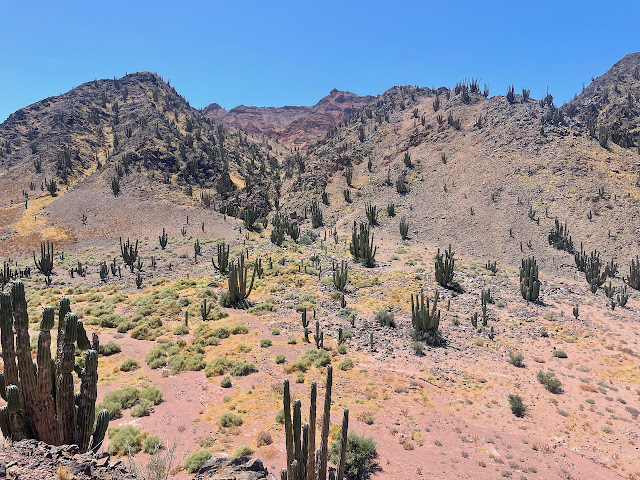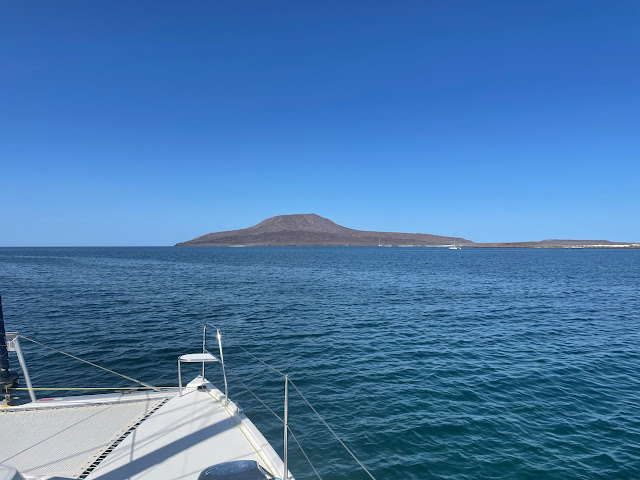Puerto Escondido, Baja California Sur
This post brings the blog up to date on Intermezzo’s 2023 cruise since launching in Puerto Escondido on January 10th.
I had originally planned to launch Intermezzo in November, but there was a mix up and I ended up with no slip for the boat in the marina. I didn’t want to leave Intermezzo on a mooring at the tail end of hurricane season or while I was away for the holidays when strong northerlies often blow in the Sea of Cortez. So I postponed the launch date to after the New Year.
Ben, a member of my men’s group, joined on as crew, arriving right after I launched Intermezzo. It was his first time sailing and he came aboard enthusiastic and motivated to learn. We spent a few days getting the boat ready and provisioning and then set sail on for La Paz on January 13th.
Our journey began with a brief snafu, our anchor failing one of the floating breakwater’s mooring cables as we left the dock. We had been “med moored”, with the stern of the boat tied to the dock and the bow held out by our anchor. There aren’t many mooring cables, but we found one. The marina sent out a diver and we were soon untangled and on our way.
We had a very pleasant passage with good weather to La Paz, stopping at anchorages in Agua Verde, Los Gatos, Isla San Francisco and Isla Partida along the way. We arrived in La Paz on January 19th and Ben departed the next day to get back to graduate school. Ben did a great job as crew, I think he learned a lot about and enjoyed the sailing life. We got along well, though he nearly ate me out of house and home. He’s an ultra-marathoner and has the metabolism to pack away twice the calories as me.
I spent the rest of January at anchor in La Paz, doing boat chores, getting some consulting work done, eating at my favorite La Paz restaurants, a dinner with my friend Johan. It was sunny but windy and chilly most days.
My new Starlink internet service is a game-changer for living at anchor, off the grid. I ordered the system and had it delivered to the marina in Puerto Escondido and got it up and running easily before we left. The system consists of a satellite antenna, which we call “Dishy”, a WiFi router, a cable to connect the two, and it plugs into the boat’s A/C power circuit. It is the RV version of Starlink, now called “Roam”. The antenna sits on a four-legged metal base that can be positioned anywhere on the boat with a clear view to the sky. While this requires that the antenna be stowed while underway and set up again when at anchor, it has given me the opportunity to try the system out before considering a permanent installation.
Starlink’s performance has been outstanding, routinely and reliably providing download speeds in excess of 100Mbps and upload speeds in the 10Mbps range. It consumes about 6 amps at 12VDC, about the same as the refrigerator, which means I have to monitor power consumption and best to turn it off whenever I’m not using it. The hardware cost less than $400 and the service costs about $75/month. I can make phone calls (over WiFi), download large files, participate in online meetings, do virtually anything that I can do at home on land while bobbing in a remote anchorage. I can now be as connected as I want to while living on the boat. The turning off to save power and the stowing while underway means that it’s not a continuous connection, but I actually like the breaks. It’s similar to a parent limiting a child’s onscreen time, allowing me to disengage from the social thrum and pay more attention to my surroundings and the natural world.
Robin joined me and Intermezzo in La Paz on January 31st and we set sail for Mazatlan on February 3rd after waiting out a norther for a couple of days. We enjoyed mostly downwind sailing all the way to Bahía Tenacatita, arriving there on February 16th with stops in now familiar anchorages of Chacala, La Cruz, Chamela and Paraíso. We stayed in Tenacatita for nine days, enjoying the warmer weather, the beach, paddle boarding, and taking several kayak trips through the mangrove estuary to “The Aquarium” beach, where we snorkeled and enjoyed meals and beers at beach restaurants. It was the first time I’ve seen crocodiles in the estuary, slightly disconcerting when one is sitting in an inflatable kayak, low in the water. The ones we saw were only a few feet long, though. Nippers, not man-eaters.
On February 25th we took a slip in the marina at Barra de Navidad. Robin departed for home on March 1st and I headed back to The Ranch a few days later to work on getting my Sailing Intermezzo book printed and published, with limited success.
I returned to Barra on March 26th, a week later than planned due to a surprise visit to the emergency room due to severe pain in my upper-right torso. All life-threatening causes were ruled out at the ER and the pain was quickly relieved with painkillers and anti-inflammatory drugs. The cause of the pain was a mystery until my primary care doctor diagnosed it to be caused by Slipped Rib Syndrome, an inflammation of the connective tissue between the ribs and the vertebrae and/or sternum. I was relieved to know what went wrong and how to treat it. I couldn’t imagine sailing singlehanded with the pain I experienced.
I was pleased to find crew for the passage north back to La Paz via the CrewSeekers website. Philip joined Intermezzo on March 28th in Barra. He’s from the U.K. on a long break from his work in IT and wanted to do some sailing while in Mexico. He owns a share of a boat in the Solent, has an Atlantic crossing under his belt and has chartered boats in the Med. Very competent crew.
We departed Barra on March 31st, retracing the southbound route but skipping stops in Tenacatita, Paraíso and La Cruz. Our journey started off with a pleasant surprise; a downwind sail on a southerly breeze. But it soon turned into the expected bash against strong northerly headwinds and steep seas. The bashing ranged from mild to severe. Conditions were especially bad as we approached and rounded Cabo Corrientes, just south of Puerto Vallarta, even though I had timed our rounding of the cape to occur in the middle of the night when conditions should have been more calm. We motored hard into 20-knot winds and steep over 2-meter waves.
The boat took on quite a bit of water into the starboard hull (“my” side of the boat). The gasket for the hatch above the head (bathroom) has a gap in it, and shipped a fair amount of water as waves washed over the deck. I discovered that my 2020 repair of a leaking hull-to-deck joint has failed, allowing water to get into the food locker, ruining my paper coffee filters and dampening my chocolate and cookies, vital food supplies. The starboard engine room suffered from saltwater spray through a thin crack I discovered in the hull-to-deck joint. The port engine room shipped water from a failed hatch gasket. Nothing like severe bashing to discover where your boat isn’t watertight.
At 4:00am on April 2nd, after rounding Cabo Corrientes and ducking into Banderas Bay, I came closer to shipwrecking than I ever have in over 50 years of sailing. Much, much too close, a near miss of jagged rocks. A story deserving of its own blog post. Luckily, with the help of a nearly full moon, we steered away from the rocks and navigated successfully out of the hazardous waters in which we were accidentally sailing. I was wide awake and breathing hard for hours afterwards. I actually looked up at the moon and thanked it out loud, feeling sincerely grateful and under its protection.
I normally would have waited out the stronger winds and bigger seas in anchorages so that the bashing would be mild to, at worse, moderate. But I had a rendezvous date with Christina, Nate and Maddie in La Paz and didn’t want to inconvenience them by arriving late. As they say, the most dangerous type of sailing is sailing to a schedule.
We crossed the Sea of Cortez from Mazatlan on April 6th, mostly a bash of a crossing, the winds at just enough of an angle for us to motor sail, but the waves not far enough off to avoid the bows rising and slamming down on them. We were treated to a nice reach of a sail for the final six hours before we anchored in Los Frailes, a welcome end to the crossing.
It felt so good to be back in The Sea, along the beautiful arid Baja peninsula and among its islands. I enjoy the mainland coast of Mexico, but it does not compare to how much I love The Sea. It feels like a home to me, somewhere I belong. I love the stark beauty of the land, not softened by vegetation, all the hues and colors of the geology visible, and appreciate the toughness and tenacity of the plants and animals that live on it. I love the many colors of The Sea, how it can be calm and inviting, rough and foreboding, warm and cold, and the abundance and richness of all the life forms that it supports, in contrast to the land. I love the birds, the turtles, the dolphins, the fish. I love the brilliance of the stars at night, how our neighbor planets stand out shining brightly in the sky, clearly so much closer to us. I love that there aren’t many people cluttering up the place. I could go on, but I think I’ve made it clear how good it felt to be “home”.
The weather was then thankfully fair and mostly calm the rest of the way to La Paz, where we arrived on April 9th, right on schedule for the change of crew.
All the bashing up the coast from Barra caused me to reconsider my longer term plans. I had planned to bring Intermezzo up to San Francisco to take a break from sailing and do a major refit on the boat. The prospect of bashing up the Pacific coast of Baja and then up the California coast, 1,200 miles of mostly bashing, was not something I wanted to do. I wasn’t ready psychologically and Intermezzo, with its multiple leaks, wasn’t ready either. It got me to thinking and I came up with a better plan, one that would avoid bashing, save money, allow me to explore the northern Sea of Cortez and, ultimately, avoid sailing back 1,200 miles when my break and the refit was over. More on that plan in a future post.
Philip left Intermezzo on April 11th. He served as great crew, enduring the bashing and near shipwreck in good humor, was good company during our rest stops and didn’t eat me out of house and home, though we seemed to be always a bit short on beer.
Christina, Nate and Maddie, Renée’s daughter, son-in-law and granddaughter, respectively, my family, joined Intermezzo as Philip left. We stayed in Marina de La Paz for a couple of days, which turned out to be a good decision as Christina and I fell ill from eating something poisonous at a taco condiment bar. We were completely down and out for 24 hours.
Fortunately, we were recovered enough to leave La Paz on April 13th and begin a leisurely trip north here to Puerto Escondido this past week. We enjoyed beautiful weather, no bashing, some nice sailing, and relaxing stops at Isla Partida, Isla San Francisco, and Puerto Los Gatos, all my favorite anchorages. Nate stood several watches and I now rate him as competent crew. I hope to be able to Shanghai him into service in the future. Christina enjoyed a nice break from work, got a lot of reading done. Maddie swam, kayaked, paddle-boarded, snorkeled, played on the beach, went hiking, did schoolwork, put on a five-act play with stuffed animals, talked a lot, and consumed her fair share of the ship’s provisions. It was fun having them on board, a pleasure sailing with them in such nice weather at such a relaxed pace.
We arrived in Puerto Peñasco yesterday, three months and a week and 1,409nm since I left with Ben in January. I’m going to stay here for about a week before I begin heading north to Puerto Peñasco, sailing in waters and visiting places new to me along the way, a trip that I will chronicle in this blog.
 |
Puerto Escondido
|



































